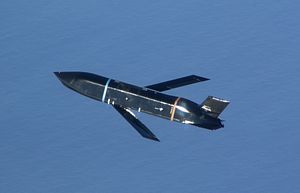The U.S. Air Force and U.S. defense contractor Lockheed Martin successfully test fired two production configuration Long-Range Anti-Ship Missiles (LRASM) from a B-1B Lancer long-range strategic bomber over Point Mugu Sea Range in California this month, Lockheed Martin said in a May 23 statement.
According to the company, it was the second time that it demonstrated hitting a moving ship with two LRASMs at once. “The missiles navigated through all planned waypoints, transitioned to mid-course guidance and flew toward the moving maritime target using inputs from the onboard sensors,” according to Lockheed Martin. “The missiles then positively identified the intended target and impacted successfully.”
The previous test launch of a LRASM, officially designated AGM-158C, took place in March 2018. Prior to that, the last test occurred in December 2017, which involved the firing of two LRASMs from a B-1B successfully hitting a moving naval target.
The LRASM is a next-generation anti-ship missile with standoff capabilities, designed to detect and destroy specific targets within groups of surface warships in electronic warfare environments. It is a derivative of the Joint Air-to-Surface Standoff Missile – Extended Range (JASSM-ER), a long-range cruise missile with an estimated range of up 1,000 kilometers (620 miles). As I explained in August 2017:
The LRASM began as a joint research project by the Defense Advanced Research Projects Agency (DARPA) and the U.S. Navy in 2009. The aim of the LRASM project was to deliver a new generation of anti-ship missiles with standoff capabilities — in other words, missiles with extended range, which would enable ships and aircraft to launch the weapon without being exposed to enemy counter fire. According to Lockheed Martin, the subsonic LRASM has an estimated range of over 320 kilometers and is fitted with a 450-kilogram penetrator and blast fragmentation warhead.
The LRASM is expected to complement two other anti-ship missiles, the RGM-84D Harpoon Block 1C and the fifth-generation over-the-horizon Kongsberg Naval Strike Missile (NSM). “As LRASM moves toward early operational fielding for the U.S. Air Force and U.S. Navy, the weapon system continues to demonstrate critical capabilities that our warfighters need,” said David Helsel, LRASM program director at Lockheed Martin Missiles and Fire Control.
The LRASM is to be integrated on board the B-1B in 2018 and on the F/A-18E/F Super Hornet in 2019. The LRASM is part of the U.S. Navy’s “Distributed Lethality” concept of operations. In order to implement this new warfighting concept, the service requires a stealthy long-range, anti-ship cruise missile.
































